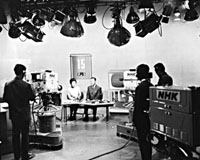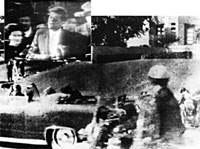
| The year 1960 brought political upheaval with the revision of the U.S.-Japan Security Treaty. TV screens flickered with images of controversies that were shaping Japan's future. Television also entered a great period of growth in the 60's with the spread of color TV. |
On the air from morning till night |
| TV in living color
In Japan, 1960 was a year of constant tension. The revision of the U.S.-Japan Security Treaty polarized domestic opinion. But this year was also the start of a period of dramatic growth for TV, which began airing from morning into the night. Programs in color began to appear and television really took off. The first color broadcasts, in September 1960, were mainly movies and sports telecasts. Color broadcasts quickly increased with the approach of the Olympics. The Tokyo Olympic Games gave Japan an opportunity to show the world its achievements in TV technology and broadcast production. News shows in the morning From around 1961, TV broadcasts began to span the day from morning to night. This was a period when the morning was regarded as a barren and undeveloped time slot as there were still few viewers. NHK launched its morning version of NHK News in 1960, followed by the Morning Drama serials in 1961. The audience share for the time slot from 8:15 a.m. tripled to more than 10% as TV viewers got into the habit of watching NHK in the morning.
|
As new methods of collecting and presenting news in a TV format were developed, TV news evolved from mimicking newspapers to having a style of its own, giving birth to news shows conducted in chatty, everyday language that welcomed the expression of frank opinions. The first U.S.-Japan satellite relay
|


